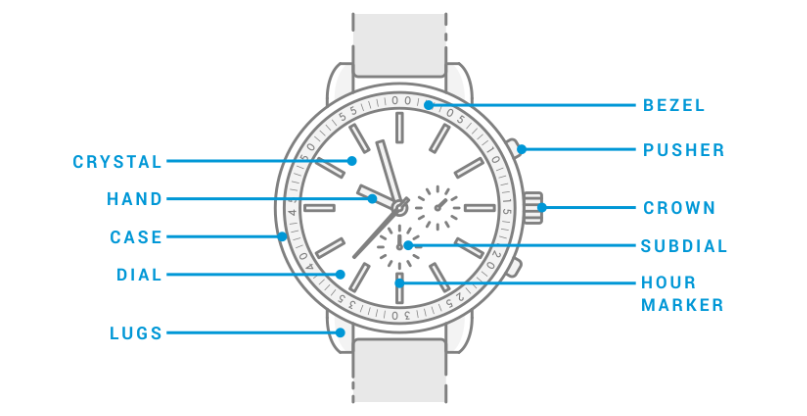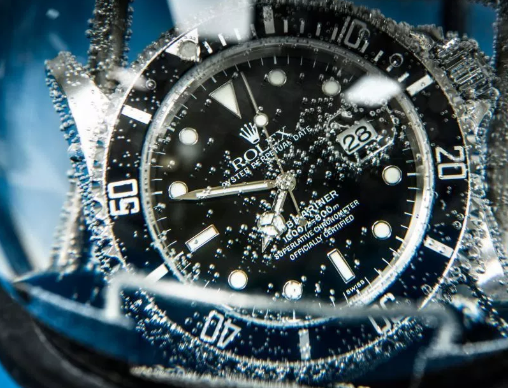To create a fine watch timepiece, a number of components must be designed, created and assembled by a team of highly skilled watchmakers. Each watch model (or reference) will have different look and will possess unique functions so it must be crafted with different components.
The watch diagram below outlines the basic elements in fine watches to build a basic understanding of their technical makeup. Understanding the anatomy of luxury watches will help in selecting the style of watch best fit for you. Let’s start with a rudimentary breakdown of a watch’s parts.

Case
The case holds the inner working parts of the watch. Depending on the style of the watch, the case is usually made of stainless steel, because steel is resilient, handles light shocks that the watch could receive, and doesn’t tarnish. It can also be made of precious metals like gold or platinum, and can even be made of plastic in sports watches.
The case can also come in different finishes like high-polish, smooth, matte, or a combination of any of those. It also contains the movement itself, be it electronic (quartz) or automatic (self-winding). We’ll cover more on movements later.
Lugs
The lugs are where the case of the watch connects to the strap or metal bracelet of the watch, by use of metal spring bars.
Crown
The crown is what is used to change the time. Some watches offer a date window and a seconds indicator, which are engaged by pulling the crown out. Crowns on water-resistant watches screw down into the case. The crown can have embellishments like precious stones, to indicate luxury and attention to detail.
Strap / Buckle

The strap/buckle secures the watch to your wrist and there are a number of materials commonly used for these parts. Leather straps range from calfskin to lizard and more exotic offerings like ostrich, alligator, crocodile, and even toad. Instead of a strap, a metal bracelet is a popular option. Other options are nylon straps (for sportiness), satin straps (for dressiness), and rubber straps (for diving/watersports).
Most watches allow straps and bracelets to be interchangeable so you can dress it up or down when you want to change the look of your watch. We have several articles on watch straps which can be found here.
Hands
The hands, usually broken down into hours and minutes, indicate the time. The hour hand is usually shorter in size than the minute hand. The hands can also have a slight design to them.
Other more complicated watches, such as chronographs (stop watches / timers), may have additional hands for their other functions, known as “complications”.
Bezel
The bezel is the outer ring of the case that connects to the lugs. It is typically a flat-edged surface, but can also be rounded. The bezel can also have embellishments, like precious gemstones in upscale watches, and may be a different metal than the case itself, as in some two-tone watches.
The above pictures show three different kinds of watch bezels. The one on the left rotates is Rolex Deepsea D-blue watch, allowing the user to “set” a different time zone. While the other two are fixed, such as the “fluted” bezel on the middle Rolex Datejust Rhodium Dial Jubilee watch, and rounded one on the right Patek Philippe Complications Wristwatch.
Crystal
Made of glass, plastic or synthetic Sapphire, the crystal is a transparent cover that protects the watch dial and reduces glare.
Dial / Face
A plate, with a metal base and visible through a crystal, that carries certain indication, such as the hours, minutes and sometimes seconds.
SUB-DIAL
A small dial placed inside the main dial on a watch’s dial that give information not provided by the main watch dial such as a chronograph.
Date Window
Considered part of the calendar family, a date window will be the only numbers found associated with the date. Popular places to find the date window are: 3 o’clock, 12 o’clock and 5 o’clock.
MOVEMENT
Acting like an engine, a movement is the inner mechanism of a watch that keeps time and powers the watch’s functions.
PUSHER
Button(s) located outside of the case that control specific functions of the watch. Pushers are most commonly found on watches with a chronograph.
That’s all, next time we’ll talk more about the watch movement, Watch Complications (Functions) etc.













